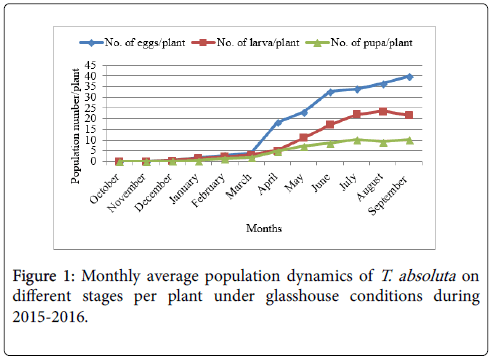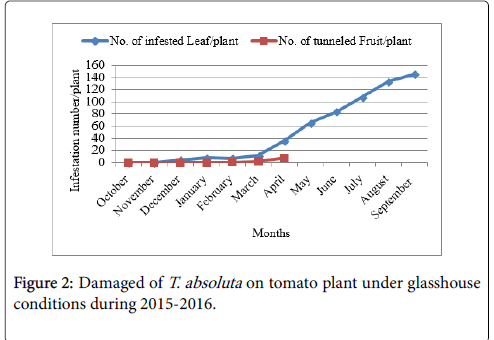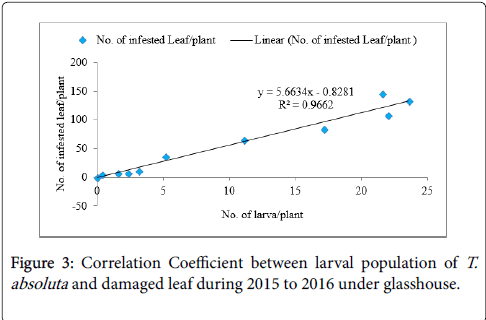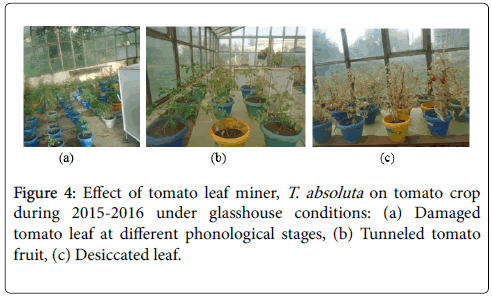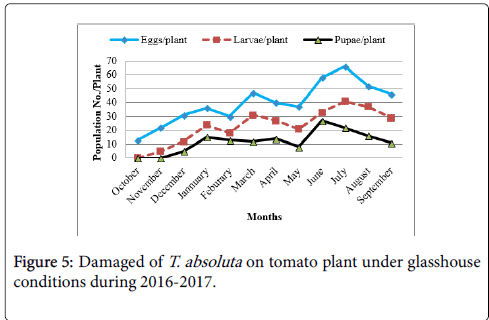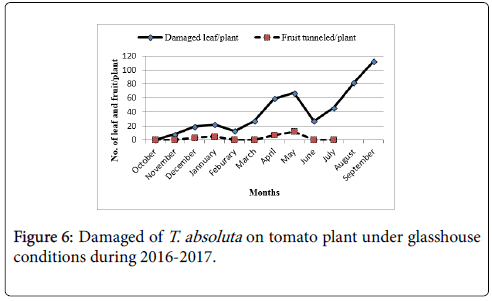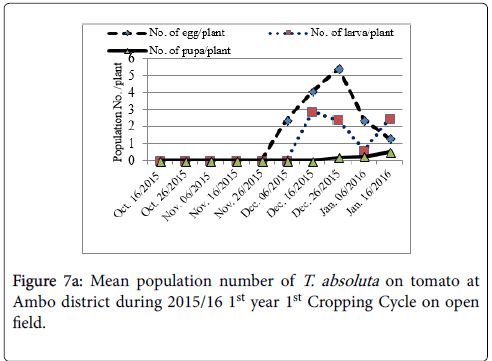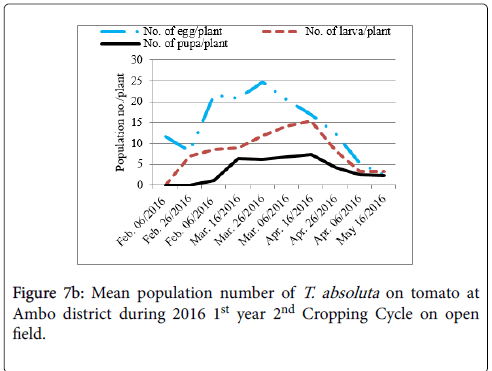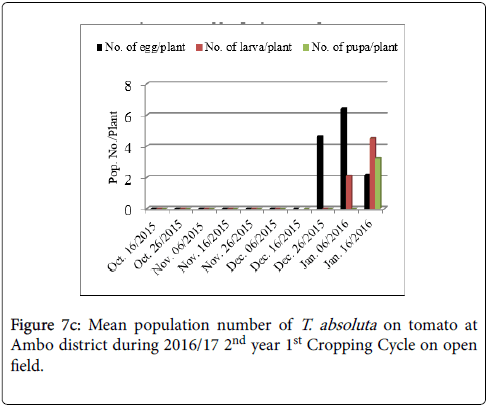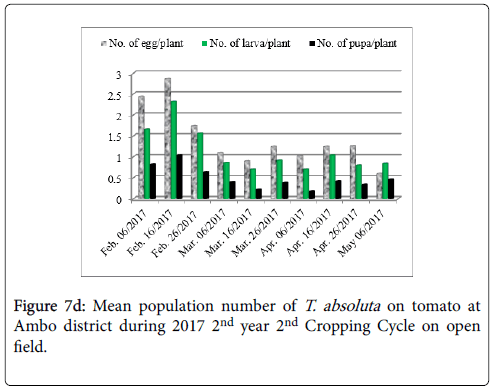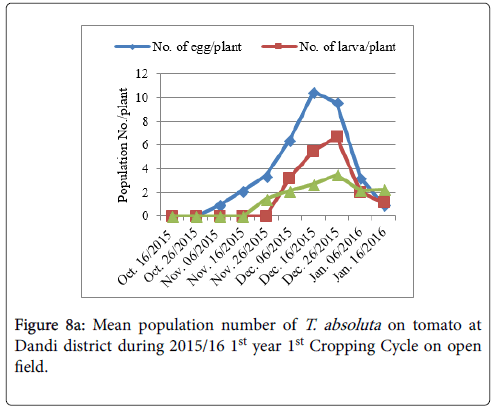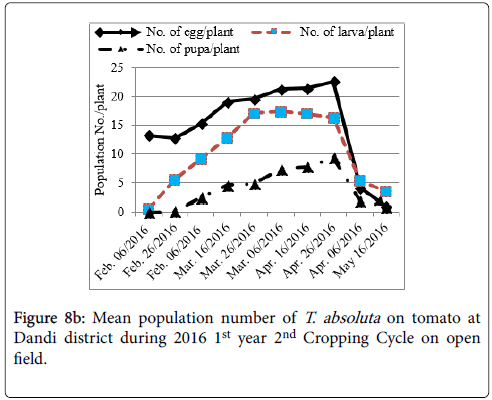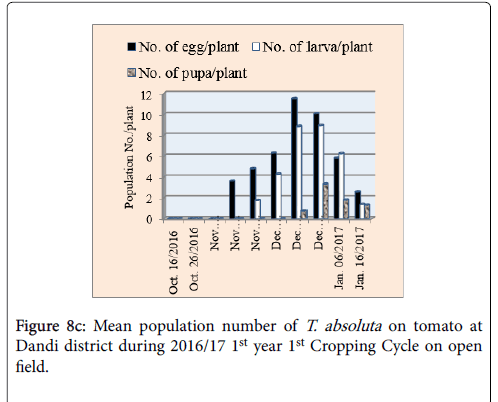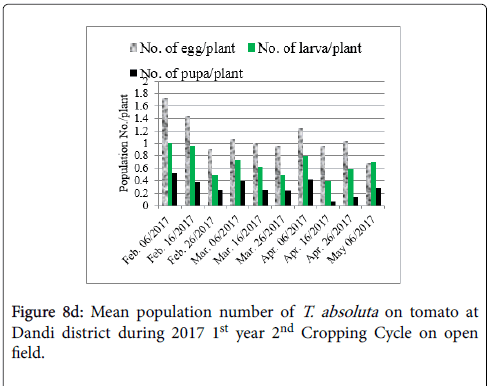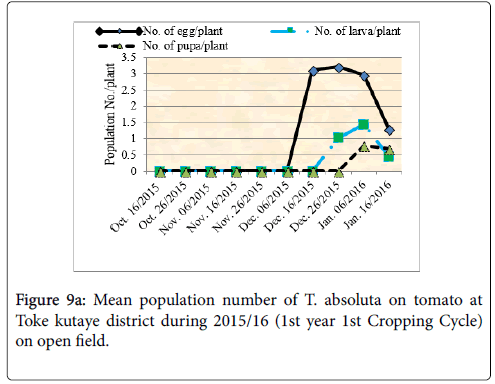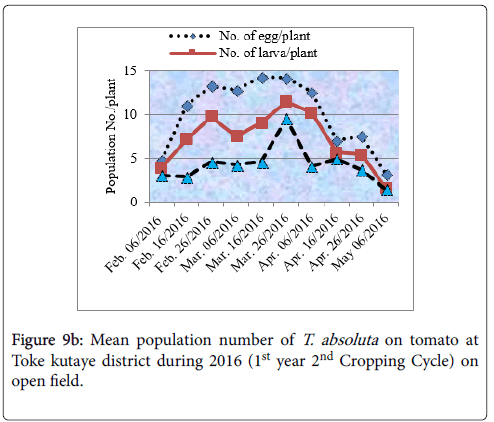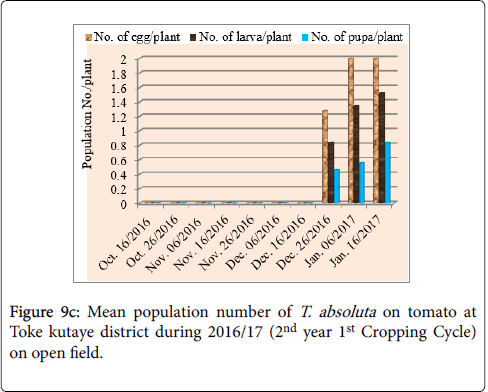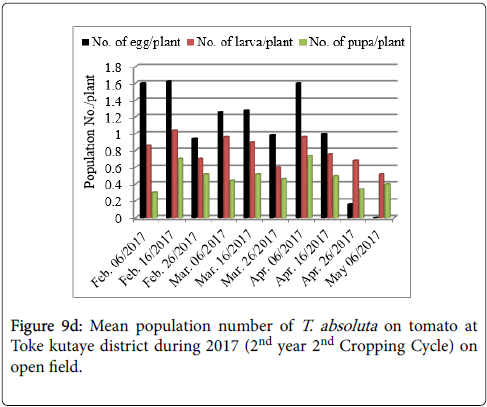Population Dynamics Study of T. absoluta in Western Shewa of Central Ethiopia
Received: 11-Apr-2018 / Accepted Date: 08-May-2018 / Published Date: 15-May-2018 DOI: 10.4172/2329-8863.1000361
Abstract
Tomato leaf miner, Tuta absoluta (Meyrick) (Lepidoptera: Gelechiidae) is an important pest infesting Solanaceous plants all over the world. It became a problem on tomato crop since 2012 in Ethiopia. For enhancing the IPM control of this pest, very few studies have been conducted for assessing seasonal abundance and spatial distribution in Ethiopia. This study aims to monitor the population fluctuation and infestation rate of T. absoluta on tomato crop under glasshouse and open field conditions. Different stages of T. absoluta were investigated in glasshouse during three plantation periods in 2015-2016 and four plantation periods for open-field study in 2015-2017. Different stages of T. absoluta were investigated in glasshouse and open fields during 2015 to 2017 for six and four plantation periods, respectively. At August 2016 the highest populations of T. absoluta per plant were recorded under glasshouse whereas under open fields the highest populations of T. absoluta per plant were recorded at December and March during 2015-2016. Low number of T. absoluta was recorded in the first cropping cycle at December 2015 and 2016. The field study showed that T. absoluta population progress is increasing during tomato phenologic cycle, the period of peak activities of T. absoluta compromise at vegetative time with flowering and early fruit setting stages of the crop.
Keywords: Lycopersicum esculentum ; Tuta absoluta ; Monitoring; Phenology; Glasshouse; Open field
Introduction
Tomato, Lycopersicum esculentum (L.) is one of the economically important vegetable crops and widely cultivated in the world with a total area and production of 5,227,883 ha and 129,649,883 tons in 2008. Tomato produced by small and medium scale farmers for consumption and as a source of income [1,2].
The tomato leaf miner, Tuta absoluta , originated from South America is a significant pest of tomato, as well as other solanaceous crops like potatoes, egg plants, peppers, beans and datura [1-3]. It attacks all aerial parts of the host plant (leaves, stems and fruits) and feeds within the tissues [1]. The unintentional introduction of exotic insects has resulted in a high number of established species with considerable negative economic impact like tomato leaf miner T. absoluta to the new biotic community of the world has brought several problems in different places of the world. Recently, the production of tomato has been declined due to various factors including insect pest and diseases [4,5]. There are several insect species feeds on tomato including tomato leaf miner, whose potential geographic distribution and relative abundance are mostly poorly understood, even after costly and long-standing management programs [6,7].
This invasive pest, T. absoluta is considered a serious threat to tomato production worldwide [5]. Thousands of tomato farmers are suffering from serious production losses due to devastating pest that destroying their valuable crop [4,5]. This pest can cause losses of 80 to 100% in tomato farms in glasshouse or in open fields if control measures are not properly implemented [8].
The pest was reported for the first time in Eastern Shewa of Oromia Regional State, Ethiopia since 2012 and then invaded different parts of the country [9,10]. It might have introduced to Ethiopia likely from border countries like Egypt and Sudan as these were first affected countries prior to Ethiopia [11-13].
The pest started infesting tomato farms in the eastern Shewa of the country to regions like Oroma, Tigiray, Amhara, and Gambela. Lack of strong quarantine regulations or poor enforcement of available regulations and lack of screening at the boarders are the factors behind the spread of the pest in Ethiopia and in other African countries [14]. T. absoluta can devastate an entire tomato farm, if effective control measures are not employed.
Since it was introduced to Ethiopia in 2012, there was no any control mechanisms and action plan being implemented by the government, research institutions, horticultural agency and other stakeholders to control and mitigate the progress of the spread of T. absoluta to new regions of the country. Consequently, the ongoing invasion of T. absoluta has prompted applied research to undertake studies on many aspects of its biology, ecology and population dynamics. With the infestation of the entire Ethiopian tomato growing regions by T. absoluta now an important threat, there is an urgent need to understand the management options of the pest in its invaded range and develop environmentally sustainable, economically sound and effective integrated pest management (IPM) strategies for this pest. Hence, the objective of this study was to investigate the population dynamics and evaluate the infestation level of T. absoluta under glasshouse and open field conditions.
Materials and Methods
The study on the population fluctuation of T. absoluta was conducted during 2015-2016 (for greenhouse) and 2016-2017 (for open-field study) on tomato plants. The open-field experiment was carried out under West Shewa ecological conditions at Toke Kutaye, Ambo and Dandi Districts under field conditions. Tomato cultivar `Koshoro` was planted on 1st October 2015 and 1st February 2016 for all locations and similar trends were repeated started from 1st October 2016 on second year (2016/17). In addition to field studies one glasshouse experiment was conducted at Ambo University main Campus. In glasshouse, every four-month planting was conducted started from October 1st 2015 to September 30th 2017 for 24 months.
Leaves sampling for recording eggs, larvae and pupae
To calculate the eggs, larvae, pupae and mines number of T. absoluta , on fields were divided to four sub area approximately 12 m2/ each. Each sub area with a similar number of plants to ensure that all the area was represented in the samplings. Every 10 days sampling was carried out from October to January, February to May and June to September in greenhouse and open fields. Ten plants were tagged and at each plant five leaves were collected and individually packed in labeled plastic cans then transported to the laboratory. At the laboratory, with aid of Binocular microscope, each leaf was examined and the number of eggs, mines and larvae per leaf was recorded [15]. The minimum and maximum temperature and relative humidity data were recorded during study period.
Data analysis
The data was subjected to analysis of variance (ANOVA) and the means were compared by Least Significant Different (LSD) test at 0.05 levels, using SAS program version 9.1 (SAS, 2009).
Results
Glasshouse experiment
Egg, larval and pupal-population versus months: Population dynamics study was conducted in three different cropping cycles under glasshouse conditions during 2015-2016, the results showed that significant (P<0.01) differences were observed among the months. The first cropping cycle (October to January) T. absoluta eggs and larvae had already occurred. Its egg laid numbers, larvae and pupae were gradually increased by the end of January. The graph for population dynamics (Figure 1), for the second cropping cycle (February to May), showed that the population of all stages (eggs, larvae and pupae)/plant were increased in the beginning of May to September even the flying adults also highly populated in the glasshouse (Table 1 and Figure 1).
| Mean different stages of population | Infestation | ||||
|---|---|---|---|---|---|
| Months | No. of egg/plant | No. of larva/plant | No. of pupa/plant | Mean no. of Leaf | Mean no. of Fruit |
| October | 0.00d | 0.00e | 0.00e | 0.00f | 0 |
| November | 0.00d | 0.00e | 0.00e | 0.00f | 0 |
| December | 0.57d | 0.37e | 0.27e | 4.63f | 0 |
| January | 1.70d | 1.57de | 0.33e | 5.56f | 0.3 |
| February | 2.87d | 2.33de | 1.37e | 8.92f | 0.8 |
| March | 3.83d | 3.17de | 2.0d | 11.37f | 2.15 |
| April | 18.27c | 5.17d | 4.83c | 36.17e | 7.67 |
| May | 23.2c | 11.13c | 7.13b | 65.07d | *** |
| June | 32.80b | 17.17b | 8.60ab | 84.17c | *** |
| July | 33.93b | 22.03a | 10.31a | 107.73b | *** |
| August | 36.47ab | 23.60a | 9.20a | 133.27a | *** |
| September | 39.83a | 21.60a | 10.30a | 145.33a | *** |
| LSD at 0.01 | 5.69 | 3.63 | 1.93 | 14.85 | |
| SE ± | 3.34 | 2.13 | 1.14 | 8.72 | |
| CV (%) | 20.72 | 23.66 | 25.09 | 17.52 | |
Table 1: Mean population and number of T. absoluta damaged on tomato under glasshouse conditions during 2015-2016.
Leaf and fruit damage versus months: Leaf damaged and fruit tunneled of tomato plants are caused by larval instars occurs throughout December-September (Table 1). Leaf damaged and fruit tunneled of tomato plants are caused by larval instars occurs throughout the year. The results presented on Table 1 showed that highly significant (P<0.01) differences were recorded among the months. According to our results, damage on tomatoes was much larger in the third cropping cycle followed by second, apart from damage on tomatoes in the first cropping cycle, with tomatoes plants from the second cropping cycle, gradual increasing of damages on the leaves. In this cycle, the largest and most evident were damages on the leaves due to the high larval population occurred and also the mean temperature of the glasshouse 20.5-32.5°C during this cropping cycle.
Note: Means with the same letter(s) in columns are not significantly different for each other. All treatment effects were highly significant at p<0.01 (DMRT). *** Due to highest damaged of T. absoluta the leaf became dried and no fruit setting (100% yield losses).
It is important to emphasize that with tomatoes from the first cropping cycle there were damages on the leaf, flower and fruits. T. absoluta larvae were damaged tomatoes in the second cycle, damages on all entire part of the plant were visible (Figure 2). However, the greatest damages were found on the leaves of the plants during the third cropping cycle, because of this damaged no flowering and fruit setting of tomato during the end of second and third cropping cycle (Table 1 and Figure 3). As indicated in Table 2 the highest infestation of T. absoluta on tomato plants were detected during the 3rd cropping cycle at temperature between 20-27.5 (84.17-145.33 leaves/plant).
| Temperature (°C) | Relative humidity (%) | |||||
|---|---|---|---|---|---|---|
| Months | Min | Max | Mean | Min | Max | Mean |
| October | 24 | 30 | 27 | 57 | 68 | 62.5 |
| November | 21 | 28 | 24.5 | 52 | 55 | 53.5 |
| December | 25 | 33 | 29 | 44 | 52 | 48 |
| January | 27 | 35 | 31 | 39 | 46 | 42.5 |
| February | 26 | 39 | 32.5 | 37 | 44 | 40.5 |
| March | 24 | 37 | 30.5 | 42 | 47 | 44.5 |
| April | 23 | 35 | 29 | 41 | 46 | 43.5 |
| May | 25 | 37 | 31 | 40 | 49 | 44.5 |
| June | 22 | 33 | 27.5 | 47 | 52 | 49.5 |
| July | 20 | 28 | 24 | 60 | 66 | 63 |
| August | 16 | 25 | 20.5 | 55 | 60 | 57.5 |
| September | 18 | 27 | 22.5 | 56 | 62 | 59 |
Table 2: Mean temperature and relative humidity during 2015-2016 under glasshouse conditions.
Population density and damages are presented in Figure 3 for each month of observation. Egg, Larval and pupal density of T. absoluta and months of observations were a strong positive correlation and linear relationship between those two variables. Damaged leaf and tunneled fruit revealed significant (p<0.05) positive correlation in both the years i.e., 2015 to 2016. The linear regression co-efficient 'b' value during the same year was significant with higher r2 value showing more pronounced effect of T. absoluta eggs, larvae and pupae on leaves. The highest value of r2 (0.966) indicated 96.6% variation in yield due to T. absoluta larvae damaged of leaves (Figures 3 and 4). The regression equations derived were below:
During second year (2016-2017) study period the population number of all stages of T. absoluta were increased during months of June to August 2017 under glasshouse conditions. The infestation level of T. absoluta larvae was very high during months of July and August 2017. Due to highly damaged leaves the plant becomes dead at flowering stage and no fruit setting was observed (Figures 5 and 6). As compared with first year (2015-2016) the infestation level and population number of the pests somehow similar.
Field Experiment
Egg larval and pupal-population versus months
The present study, statistical analysis showed that significant (P<0.05) differences were observed among the treatments. Tuta absoluta was observed in two main cropping cycles at Ambo, Dandi and Toke kutaye districts, although the maximum density was found in all study areas. The results of the three study areas in first year (2015/16) in both cropping cycles are presented in Figures 7a-9d. At Ambo district first cropping cycle T. absoluta population revealed steady progressive (after crop transplanted) to the field and maximum population recorded in the late of December (5.4 eggs/plant and 2.36 larvae/plant) and declined thereafter. In the second cropping cycle peaked in the late March (24.62 eggs and 11.74 larvae/plant) were recorded in the same district.
During 2015/16, at Ambo district first cropping cycle eggs were first recorded at the beginning of December (Figure 7a) whereas at Dandi district, eggs were first observed at beginning of November (Figure 8a). On the other hand, at Toke kutaye eggs were first found at the mid December (Figure 9a). The first peak was observed at the vegetative to initiation of flowering of the crop at all study areas. The second period of T. absoluta activity occurred at the beginning of February at all locations. Similarly, the peak of T. absoluta eggs and larvae at Toke kutaye in the first and second cropping cycles were recorded at mid- December (14.26 eggs/plant and 9.06 larvae/plant) and the population remained high up to the end of April (Figures 9a and 9b), respectively.
The insect infestation appeared in the early November at Dandi compared with Ambo and Toke kutaye (Figure 8a). The early appearance of T. absoluta at Dandi in this particular cropping cycle was associated with early planting of the crop in the surrounding farmer’s fields. It was recorded highest population number at mid- December (10.48 eggs/plant). In the second cropping cycle the population of egg, larva and pupa of T. absoluta were high at the end of April (22.62 eggs/plant, 16.30 larvae/plant and 9.36 pupae/plant) compared with Ambo and Toke kutaye in all cropping cycles (Figure 9b).
The overall impacts of T. absoluta at Ambo and Toke kutaye districts, the populations were very low in the second year in both cropping cycles as compared to the previous year. T. absoluta had two peaks per year, the first peak December months at all study areas, whereas the second peak recorded at the end of March and the beginning of April (Figures 7a, 8d and 9d). The different stages of T. absoluta (egg, larva, and pupa) begun to increase at vegetative stage of the crop before fruit setting and peak numbers attained at flowering stage. During vegetative and flowering stage, most of the product of photosynthesis move upward to developing fruits, at vegetative period the adult T. absoluta concentrated to laid eggs on the upper young leaves and developing fruit as it was observed in all occasions.
In all study areas, the maximum eggs laid were found at vegetative stages followed by flowering stages. In the first year (2015/16), second cropping cycle the population of T. absoluta in all stages (egg to pupa) found at seedling stages and the maximum populations were recorded at March (14.26-24.62 eggs/plant) and the minimum eggs were recorded at the mid of May at maturity stages. On Similar manner, at Dandi district the maximum eggs were found started mid-March to at the end of April (16.14-22.62 eggs/plant). In general, the period of peak activities of the T. absoluta compromise with vegetative time with flowering and early fruit setting stages of the crop. As a result, large populations, consisting larvae damage the crop leaves at vegetative and then passed to fruit. In 2015/16, patterns of abundances were similar to those of 2016/17. However, in 2016/17 at Ambo and Toke kutaye first and second cropping cycle the population of T. absoluta eggs, larvae and pupae were low as compared to Dandi district.
Discussion
T. absoluta is a key pest of tomato crops in West Shewa of Ethiopia causing high losses. The knowledge of its population dynamics under laboratory, glasshouse and open field conditions is considered as major step to plan effective management strategies. The present results showed that T. absoluta eggs and larval population number evolving at Ambo glasshouse was larger than that of all field studies. This number was influenced perhaps by abiotic factors like temperature, insecticide applications, distance between glasshouses and by biotic factors i.e., absence of natural enemies. Our results confirmed the previous studies of Miranda et al. they reported that during the first phonologic stages of the crop, tomato plants are free from attack of Tuta absoluta [16]. The average temperature recorded at this period was approximately 20-25°C. Their number became relatively high, as their attack became intense towards at vegetative stage of crop cycle. These results matched with those found by several authors [17]. These authors underlined the occurrence and increase in T. absoluta captures during the crop season.
Allache and Demnati mentioned that in Algeria, during the first phonologic stages of the crop, tomato plants are free from attack of T. absoluta [18]. Harizanova et al. pointed that the leaves were the most heavily damaged plant parts [19]. Leite et al. found that the attack of T. absoluta was severe at the end of growing season, these authors suggested removal of crop residues and rotating with crops that were not suitable host for this pest [20]. T. absoluta females deposited their eggs on all plant parts, they prefer laying eggs on leaves [21,22]. Thus, their numbers were high on the upper than lower leaf surface. In the present study, most of eggs deposited on upper leaves were taken into account. However, minimum egg laying in October and May was recorded. The nutritional quality of tomato leaves (terpenes) seemed to have a positive effect on the laying behaviour of T. absoluta [20]. The number of eggs increased in the three study areas in the first and second year, second cropping cycles (from mid-February to the end of the cropping cycle).
The tomato leaf miner, T. absoluta eggs number evolution in the glasshouse study was different from that of field studies. The number of eggs mentioned in this work was low compared with results of Pereyra and Sanchez [23]. After Miranda et al., natural enemies played an important role in controlling tomato pests and their preservation by farmers was necessary [24]. T. absoluta was attacked at its various stages by several natural enemies, however the rate of parasitism was variable according to species [22,25]. T. absoluta pupation was frequent in the leaves but the pupae might be found in the ground, mainstem and in fruit [21].
In Ethiopia, T. absoluta resistance to pesticides was not studied. To manage this problem, using integrated pest management (IPM) and other alternative approaches, reducing pesticides use and preserving natural enemies by growers might be a solution [24,26]. In summary, this study highlighted that the three field study areas and one glasshouse study lodged all T. absoluta developmental stages. Moreover, it was present during all tomato vegetative cycle and on all plant parts.
Conclusion and Recommendation
Damaged of tomatoes were high in the second cropping cycle, apart from damage on tomatoes in the first cropping cycle. With tomatoes from the first cropping cycle in both years, the maximum and most evident were damages on the leaves during vegetative stage. It is important to emphasize that with tomatoes from the first cropping cycle there were damages on the leaves and fruits of tomato. It was concluded that the infestation level of T. absoluta was exist throughout the year if host is available and mostly depends on phonological stages. From this study, damages of tomatoes from the second cropping cycle, damages on all parts of the plant were visible but specifically the leaf parts totally invaded before fruit setting particularly under the glasshouse conditions. Hence, to manage T. absoluta this information can be utilized to know when to begin monitoring and control measures to be implemented.
References
- Bawin T, De Backer L, Dujeu D (2014) Infestation level influences oviposition site selection in the tomato leafminer Tuta absoluta (Lepidoptera: Gelechiidae). Insects 5: 877-884.
- Retta AN, Berhe DH (2015) Tomato leaf miner, Tuta absoluta (Meyrick), a devastating pest of tomatoes in the highlands of Northern Ethiopia: A call for attention and action. Res J Agric Environ Manag 4: 264-269.
- Urbaneja A, González-Cabrera J, Arnó J, Gabarra R (2012) Prospects for the biological control of Tuta absoluta in tomatoes of the Mediterranean basin. Pest Manag Sci 68: 1215-1222.
- Materu CL, Shao EA, Losujaki E, Chidege M (2016) Farmer’s Perception Knowledge and Practices on Management of Tuta absoluta Meyerick (Lepidotera Gelechiidae ) in Tomato Growing Areas in Tanzania. Int J of Res Agr and forest 3: 1-5.
- Chidege MAS, Hassan N, Julie A, Kaaya E, Mrogoro S (2016) First record of tomato leaf miner Tuta absoluta (Meyrick) (Lepidoptera: Gelechiidae) in Tanzania. Agric Food Secur 5: 1-17.
- Assaf LH, Hassan FR, Ismael HR (2013). Saeed S a. Population Density of Tomato leaf miner Tuta absoluta Meyrick (Lepidoptera: Gelechiidae) under plastic houses conditions (b). IOSR J Agric Vet Sci 5: 7-10.
- Gutierrez AP, Ponti L (2012) Analysis of invasive plants and insects: links to climate change. In: Ziska LH and Dukes JS (eds.), Invasive Species and Climate Change, CABI Publishing, Wallingford, UK.
- Öztemiz S (2012) The tomato leafminer [(Tuta absoluta Meyrick (Lepidoptera: Gelechiidae) and it’s biological control KSU. J Nat Sci 15: 47-57.
- Gashawbeza A, Abiy F (2013) Occurrence and Distribution of a New Species of Tomato Fruit worm, Tuta absoluta Meyrick (Lepidoptera:Gelechiidae) in Central Rift Valley of Ethiopia. Proceedings of the 4th Binneial Conference of Ethiopian Horticultural Science Society, Ambo, Ethiopia, pp: 144.
- Goftishu M, Seid A, Dechassa N (2014) Occurrence and population dynamics of tomato leaf miner Tuta absoluta (Meyrick), Lepidoptera: Gelechiidae in Eastern Ethiopia. East Afr J Sci 8: 59-64.
- Moussa A, Baiomy F, El-Adl E (2013) The status of tomato leafminer; Tuta absoluta (Meyrick) (Lepidoptera: Gelechiidae) in Egypt and potential effective Pesticides. Acad J Entomol 6: 110-115.
- Pfeiffer G, Muniappan R, Sall D, Diatta P, Diongue A, et al. (2013) First record of Tuta absoluta (Lepidoptera: Gelechiidae) in Senegal. Flo Entomol 96: 661-662.
- Brevault T, Sylla S, Diatte M, Bernadas G, Diarra K (2014) Tuta absoluta Meyrick (Lepidoptera: Gelechiidae): a new threat to tomato production in sub-Saharan Africa: Short communications. Afr Entomol 22: 441-444.
- Mwatawala MW (2013) Tuta absoluta yet another invader at the Tanzanian doorstep. Intercont Hotel Addis Ababa, Ethiopia.
- Leite GLD, Picanço M, Guedes RNC, Zanuncio JC (2001) Role of plant age in the resistance of Lycopersicum hirsutum f. glabratum to the tomato leafminer Tuta absoluta (Lepidoptera: Gelichiidae). Sci Hort 89: 103-113.
- Miranda MMM, Picanço MC, Zanuncio JC, Guedes RNC (1998) Ecological life table of Tuta absoluta (Meyrick) (Lepidoptera: Gelichiidae). Biocont Sci and Tech 8: 597-606.
- Lacordaire AI, Feuvrier E (2010) Tomate, traquer Tuta absoluta. Phytoma 632: 40-44.
- Allache F, Demnati F (2012) Population Changes of Tuta absoluta (Mey.) (Lepidoptera, Gelichiidae): A New Introduced Tomato Crop Pest at Biskra in Algeria. J Jrl of Agri Sci 8: 391-398.
- Harizanova V, Stoeva A, Mohamedova M (2009) Tomato leaf miner, Tuta absoluta (Povolny) (Lepidoptera: Gelechiidae) first record in Bulgaria. Agricultural science and technology 1: 95-98.
- Leite GLD, Picanço M, Jham GN, Marquini F (2004) Intensity of Tuta absoluta (Meyrick, 1917) (Lepidoptera: Gelichiidae) and Liriomyza spp. (Diptera: Agromyzidae) attacks on Lycopersicum esculentum Mill. leaves. Ciênc Agrotech Lavras 28: 42-48.
- Torres JB, Faria CA, Evangelist WS, Pratissoli D (2001) Within- plant distribution of the leaf miner Tuta absoluta (Meyrick) immatures in processing tomatoes, with notes on plant phenology. Inter J Pest Manag 47: 173-178.
- Faria CA, Torres JB, Fernandes AMV, Farias AMI (2008) Parasitism of Tuta absoluta in tomato plants by Trichogramma pretiosum Riley in response to host density and plants structures. Cienc Rural 38: 1504-1509.
- Pereyra PC, Sanchez NE (2006) Effect of two Solanaceous plants on developmental and population parameters of the tomato leaf miner, Tuta absoluta (Meyrick) (Lepidoptera: Gelichiidae). Neotrop Entomol 35: 671-676.
- Miranda MMM, Picanço MC, Zanuncio JC, Bacci L, Silva DEM (2005) Impact of integrated pest management on the population of leafminers, fruit borers, and natural enemies in tomato. Ciênc Rural 35: 204-208.
- Marchiori CH, Silva CG, Lobo AP (2004) Parasitoids of Tuta absoluta (Meyrick, 1917) (Lepidoptera: Gelichiidae) collected on tomato plants in Lavras, state of Minas Gerais, Brazil. Braz J Biol 63: 551-552.
- Lietti MMM, Botto E, Alzogaray RA (2005) Insecticide resistance in Argentine populations of Tuta absoluta (Meyrick) (Lepidoptera: Gelichiidae). Neotrop Entomol 34: 113-119.
Citation: Shiberu T, Getu E (2018) Population Dynamics Study of T. absoluta in Western Shewa of Central Ethiopia. Adv Crop Sci Tech 6: 361. DOI: 10.4172/2329-8863.1000361
Copyright: © 2018 Shiberu T and Getu E. This is an open-access article distributed under the terms of the Creative Commons Attribution License, which permits unrestricted use, distribution, and reproduction in any medium, provided the original author and source are credited.
Share This Article
Recommended Journals
Open Access Journals
Article Tools
Article Usage
- Total views: 5325
- [From(publication date): 0-2018 - Apr 02, 2025]
- Breakdown by view type
- HTML page views: 4396
- PDF downloads: 929

